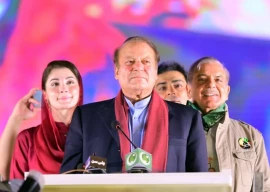
Syed mentioned the order and disorder experienced by Australian artists traveling to unpredictable countries like Pakistan, and by Pakistani artists striving for order in a shared creative space. Through mark making, erasure, repetition, and layering, the artists pushed the boundaries of print making, resulting in a travelling exhibition that began in Sydney, is currently in Karachi, and will soon be held in New York.
Abdullah M.I. Syed’s own works on display derived inspiration from Dante’s verse ‘to square the circle’ from Paradiso, the third part of the Divine Comedy. While Enmeshed Blue depicted a solar/lunar halo in aquatint, in Flare II Syed silkscreened a skull cap used for prayer. Through an on-going process of appropriating and deconstructing circular objects and symbols on embossed graph lines, Syed attempted to perform Dante’s metaphorical statement.
Roohi S. Ahmed worked with ruptured marks — a response to unsaid thoughts and feelings during her extended stay in Australia. This included lines that resemble stitches — which, to decode, “one must dip into their own cache of signs and symbols.”
The work of Michael Kempson, head of printmaking at UNSW Sydney, touched on complex, geopolitics, and the world the young will inherit. Highly detailed and neat etchings and aquatint from the Friends and Acquaintances series displayed soft animal toys including the panda (China), ibex (Pakistan), and kangaroo (Australia) that represented various nations and their relationships.
As an Australian artist of the diaspora, Ben Rak’s work spoke of his links and friendships with other cultures such as China, Pakistan and Japan, where global narratives are woven into his own. His bobble head silkscreens such as that of an Arab sheikh and Steve Irwin (the late crocodile hunter) inferred “an all-encompassing consumer culture.”

Adeeluz Zafar worked with his distinctive imagery of animal toys wrapped in gauze in stark black and white. While Untitled silkscreened a zoomed-in detail of a toy, Two headed Pup displayed, according to Zafar, “a mutant along a mythical evolutionary path… Although hidden under gauze, occasional arguments often erupt between the mutated heads and appendages, leading to attacks, wounds and even attempts to swallow each other.” Zafar’s prints could read as a metaphor for entrapment, injury and conflict of various types.
All artists exhibiting attempted to create a ‘semblance’ of order’, they strove to put their respective messages across and did so, successfully. However, their skill along with their struggle to keep the tradition of printmaking alive in the world of art, resulted in a thought-provoking exhibition that has been, and ought to be well-received wherever it is shown.
Shanzay Subzwari is a fine arts student. She tweets @ShanzaySubzwari
Published in The Express Tribune, Sunday Magazine, September 21st, 2014.































1714024018-0/ModiLara-(1)1714024018-0-270x192.webp)









COMMENTS
Comments are moderated and generally will be posted if they are on-topic and not abusive.
For more information, please see our Comments FAQ